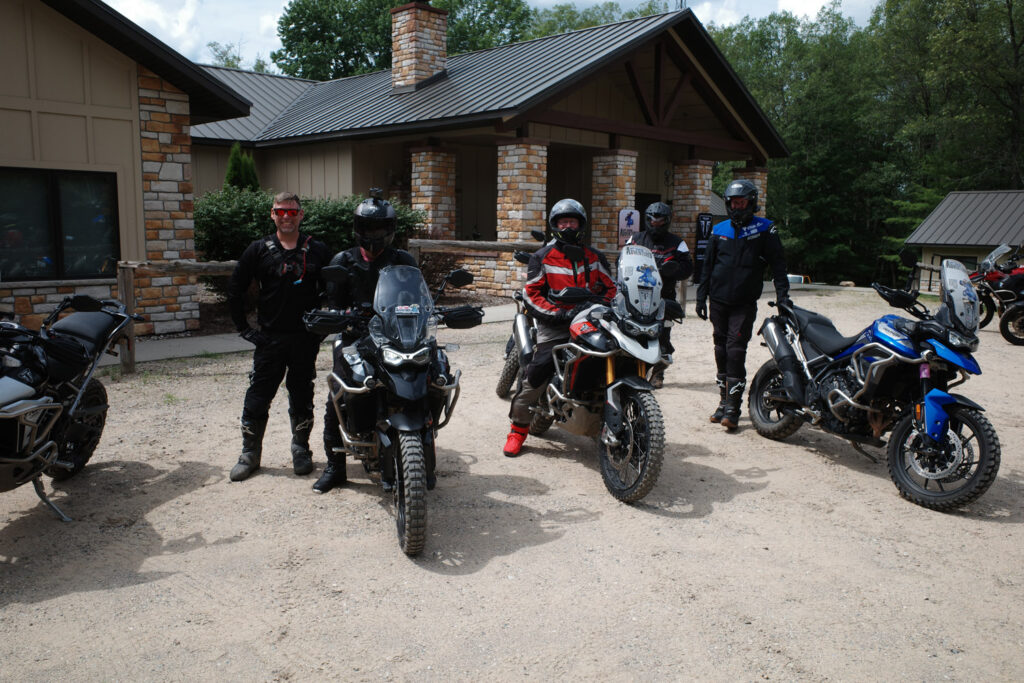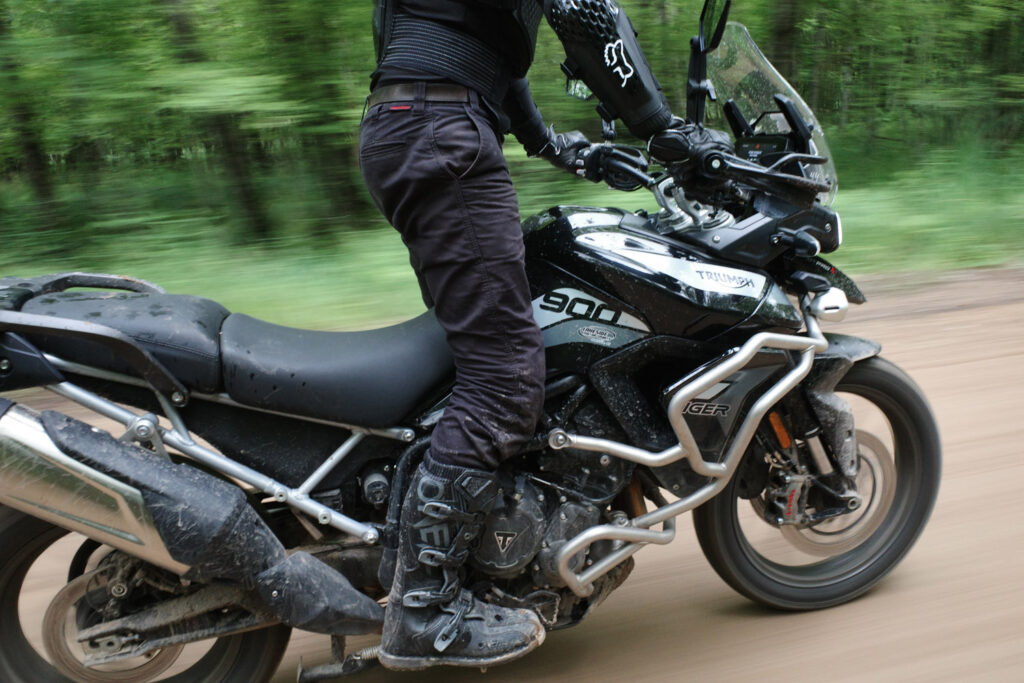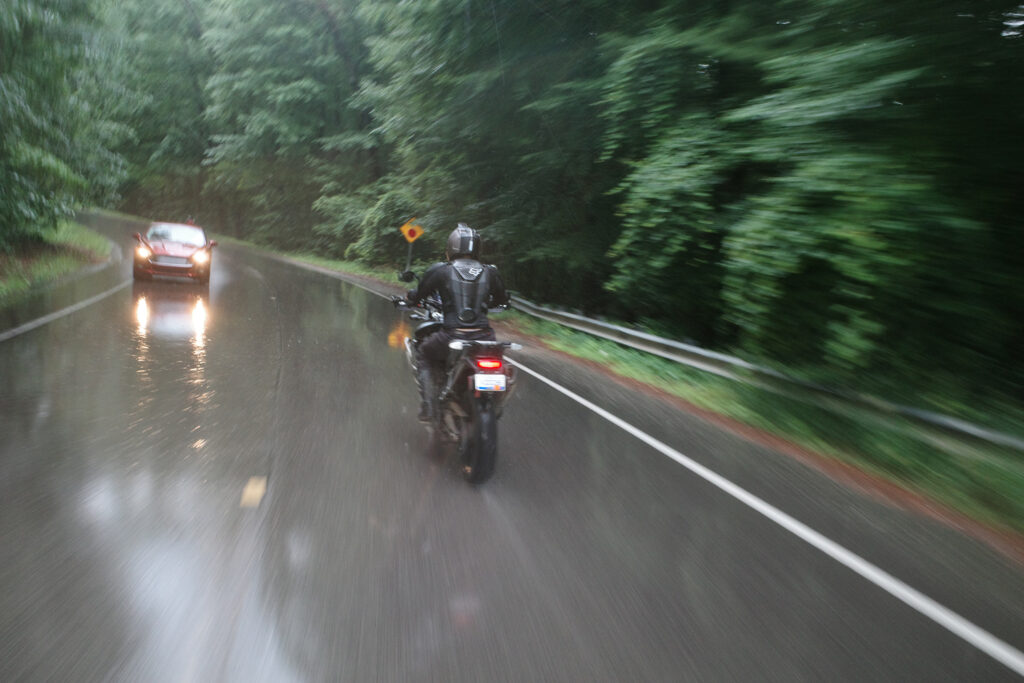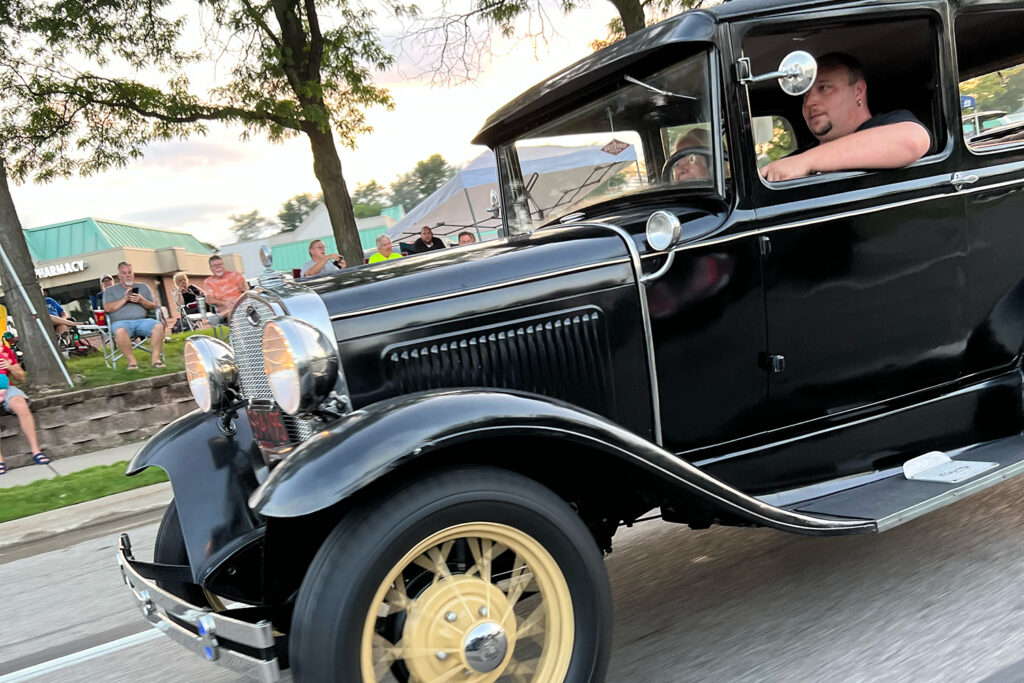Big Rapids — Eric turned 72 this year and has crashed his motorcycle twice today. The second time, it happens right in front of me. The bike goes into a wheelspin over some wet grass, and he tumbles to the ground. The 500-pound motorcycle falls on him. Another rider stops to check on the septuagenarian’s bones, but Eric rolls out from under the bike. He’s completely fine. Remounting, Eric turns to his would-be rescuer and says, “I should be able to handle those corners much better.” He reignites his vehicle then drives off. A few minutes later, he falls again.
I am taking a three-day course from Jeff Stanton Adventures on how to ride motorcycles through perilous and rugged terrain. The course is hosted at the Two Hats Ranch in Big Rapids. It’s the perfect formula for adventure: intense off-road riding combined with all-inclusive luxury. Jeff Stanton, a six-time national motocross and supercross champion, provides sparkling new Triumph Tiger 900 motorcycles and exceptional instructors who create obstacle courses and guide students through the area’s undulating trails; Two Hats provides a charming lodge, three chef-prepared meals a day, first-rate service, spacious rooms, and spa-like amenities.
I almost crashed this morning as well, on loose sand, while going fast enough to snap my ribs like a Thanksgiving wishbone. But I’m half Eric’s age and in full body armor. I’m also fueled with an adolescent recklessness, the Freudian death-drive, which wanes with age. It’s risky to drive motorcycles, especially on the tail-end of the human lifespan, but more folks take the risk than you might expect. The average age of people enrolled for Jeff Stanton Adventures slants toward 50. It’s hard to believe. Men can demonstrate such daring in their twilight years—proof that vitality is distinct from virility. Boomers are constantly taking a harsh beating, mostly for their sepia-tinged idealism, but they are models of courage.

Three other men are on this trip with me. Tom, Thomas, and the aforementioned Eric. Each is several decades older than me. Tom is a retired medical equipment salesman from Portland, Oregon. He traveled thousands of miles on his own Triumph Tiger through the Canadian Rockies to be here. With silver hair and roving experience, Tom wants to replace bad habits with good ones. Eric is the oldest of the group. With a broad face stubbled with thick white scruff, Eric seems distinctly Scottish, like Sean Connery, though he’s actually German. Eric was a mariner and the chief engineer on Great Lakes merchant ships. With his countless tattoos, like spiderwebs on his elbows, and earlobes studded from bygone piercings, he could be a retired pirate. Then there is Thomas. He’s one of America’s top plastic surgeons and owns an impressive sports car collection. Thomas rides leisurely in Ohio and isn’t comfortable on trails. Because training wheels are not an option, this course is meant to give him some confidence.
The course begins in a similar way to dating. It starts with taking the motorcycle for a little walk. Standing beside the bike and holding the handlebars, it’s like a Victorian courtship ritual—all about getting comfortable making innocent contact. Once the student can chaperone the bike with ease, there is a jump in intimacy. The student then practices with the clutch to find the sweet spot, called the friction point, which is where the bike moves from neutral into first gear. After this stage, it’s finally time to start riding, but respectfully at first. It’s an intimidating activity, and the rider must see how the motorcycle responds.
Adventure riding is much more complicated than street cruising. First, the engineering is different. An adventure bike is what happens when a mommy dirt bike meets a daddy touring bike, and together create a mechanical mutt that’s excellent for both trails and highways. It’s not motorcycle miscegenation, it’s hybrid vigor. Second, the riding style is different. Unlike driving on the road—casual and relaxed—adventure riding is done almost entirely while standing up and with full attention. The foot pegs are closer to the earth than the seat, so standing puts the rider’s center of gravity lower to the ground for more stability. The upright position allows for quick weight shifting and aggressive leaning, because so much of adventure riding is negotiating with the motorcycle when it loses traction.

The floating sensation from spinning out and drifting is closer to surfing than driving. All four extremities must be engaged constantly and simultaneously. While balancing on the pegs, one foot shifts the gear lever and the other applies the rear brake. While gripping the handlebars (sometimes for dear life), one hand manages the clutch and the other controls the throttle as well as the front brake. It’s common for novices to lose balance and twist the throttle by accident. They then look at the machine in bewilderment.
Students go through a funny progression, from denial to acceptance, when they first ride. We first blame the machine, as though it’s defective, or speak about it as if it’s sentient (“I don’t know why the bike did that?”). We then blame our physiology, as though it’s something outside our control (“My hand keeps doing it by mistake!”). We ultimately take ownership for our errors (“I didn’t go fast enough”).
It’s pride and naivete, but it’s also because there is so much to process.

This weekend, we navigate different terrain: sand, clay, gravel, asphalt, loam, mud, and hardpan. Each surface requires a specific style of maneuvering, and tire traction changes with the weather. Dry sand is loose, wet sand is sturdy; parched clay is grippy, moist clay is slippery. The adventure bike can manage everything with the correct posture and driving, and that’s the purpose of the course. We have two brilliant instructions with us—Fred and Troy—who both competed in regional motocross races and now have several safety credentials. They have a lightness of being and carefree swagger. With Jeff Stanton Adventures, both replaced their big-boy jobs with the childhood, vroom-vroom dream of riding motorcycles all day.
The course is broken up into two sections: morning lessons and afternoon trail riding.
The instruction portion consists of riding scenarios with specific challenges. This includes taking sharp turns, hopping over logs, locking the brakes, whipping out the rear wheel, keeping stable while losing traction, climbing and descending steep hills, and much more. These types of challenges, which riders will encounter naturally in the wild, are presented in isolation with demonstrations from Fred and Troy. This pedagogy makes good riders.
To acquire the necessary skills, the student must think through exercises logically as isolated steps, then deliberately execute them with intention. Once on the trails, however, thinking becomes dangerous. Instead, the rider must abandon reason and cast off common sense. Trail riding is more about feeling, intuition, and vibes. Jeff Stanton famously instructs his students: “When in doubt, throttle out.” It goes against every fiber of good judgment. Yet it works.
Thomas has some difficulty with this. It’s partly because he’s a surgeon. His medical education, which spanned decades, meant breaking complicated processes down. It’s a learning style that’s great for science but terrible for adventure riding. Too much is happening at once. Because he’s relying on his rational mind instead of on his instincts, he gets overwhelmed.

Trusting the body to perform the right action requires something that’s psychologically closer to faith—it takes a leap. Thomas is also crippled with fear. And who can blame him? Doctors and nurses often call motorcyclists “organ donors,” since this demographic is overrepresented in fatal collisions. Talk to any rider: Accidents are less about if and more about when and how bad. Fred has 16 mended bones from one crash. He’s covered in scars. Troy also has a grocery list worth of fractured anatomy.
The first night, over seafood risotto, the instructors welcomed me with a story of a journalist who snapped his collarbone on this same course last year. Thomas was the only one who winced at the anecdote.
But as the course goes on, he loses most of his fear. And though he takes slightly longer than the the rest of us, he learns every skill successfully.
What’s astonishing is that, though he’s less comfortable than the others, falling many times, he continues to ride. He could have easily broken a finger, which would keep him out of the operating room. But he was determined to learn—despite the innate instinct to age safely and securely. By embracing danger, we all came away from the course prepared to ride off-road.
We often think that old age is the domain for passivity and slow-burning wisdom, that taking risks is for the young. But mistakes become experience. With some bold disregard for caution, even old dogs can learn new tricks.
Mitch Miller is an adventure writer and conflict journalist. He’s more than happy to join in on any extreme activity, and can be reached at mitchenjoyer@gmail.com. Follow him on X at @funtimemitch.


